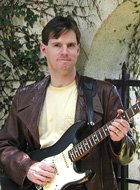>
> Hello,
> I bought the "guitar fretboard workbook" and am enjoying
> it.
> I am trying to learn guitar with your book and have no
> teacher.
> Working on the codes (triads), I got a question.
> What's the differences between the open movable codes
> (CAGED form) and the close voiced codes? Close voiced
> codes are also movable and partially barred, aren't they?
> Usages are different?
> I appreciate your answer in advance. Thank you!
Thank you for buying my book. I'm glad you are enjoying it.
The word "open" has two uses. This can cause confusion. The word "position" too has different uses for music in general and the guitar in particular. Semantic problems like this make it a good idea to talk to a live teacher once in a while. I'll nonetheless try to explain "open-position" versus movable chords, then open vs. closed voicings, all on the printed page.
First, "open" means unfretted strings on the guitar. "Position" means the location of the the first finger. "Open position" chords like the C, A, G, E, and D chords on page 44 have open (unfretted) strings included. These are called "open position chords" but since "position" means the location of the first finger on the fretboard for all other chords but these, they might better be called "unfretted-string chords."
The C and E chords might be called "first position chords" because when you play them, your index finger is usually at fret 1. But you could play them (especially the E chord) using only your 2nd, 3rd, and 4th fingers. Try both ways.
C chord
-0-
-1-
-0-
-2-
-3-
---
E chord
-0-
-0-
-1-
-2-
-2-
-0-
In the A, G, and D chords, your first finger is usually at the 2nd-fret position. But again, you could play them without using the first finger at all. Try them both ways. When we move the chords up the neck, we'll need that first finger to be free.
A chord
-0-
-2-
-2-
-2-
-0-
---
G chord
-3-
-0-
-0-
-0-
-2-
-3-
D chord
-2-
-3-
-2-
-0-
---
---
Any of these chords is only movable if you replace the open-string notes with fingered ones as you move up. If there was more than one open-string note, a barred 1st finger can be used to do the job that was formerly done by the nut of the guitar. Now the position of the chord is named by the fret where the first finger is.
By moving the E chord up one fret, for example, we get an F chord in 1st position.
F, 1st position
-1-
-1-
-2-
-3-
-3-
-1-
To sum up: "position" on the guitar means the location of the first finger, or where it would be even when you decide not to use it (!), with the exception of so-called "open-position" chords, which must have at least one unfretted string.
The chiming chords that mix open strings with notes higher up the neck are named by the position of the first finger also. This is a 7th-position B(add4) over A.
B(add4)/A
-0-
-7-
-8-
-9-
-0-
---
Next, "open voicings" (page 51) are chords where the notes are not as close together as possible. Now we are not strictly talking about strings or fingers anymore. Open voicings can be played on a guitar, an accordion, or any other polyphonic instrument by making one of the tones an octave higher or lower.
It's still the same chord name (Ami, for example) but now the notes are spread out.
Here are two open-voiced Ami chords. Don't strum all six strings. Just pluck the notes shown fingerstyle.
-0---8-
-1---5-
-------
-----7-
-0-----
-------
For comparison, a close-voiced chord has all its notes as close together as possible. Here are two close voicings of Ami.
-0---5-
-1---5-
-2---5-
-------
-------
-------
In all the above chords the notes are A, C, and E in some order. Musicians choose which version of a chord to use so they can:
1. create a melody on the top when moving from one chord to the next, or
2. create a bass line on the bottom when moving from one chord to the next, or
3. create an inner melody, or
4. make sure some notes stay the same or move as little as possible when the chords change, or
5. create a sound they like for any reason. An example of this might be Jimi Hendrix's open-voiced chords in "Castles Made of Sand" that he apparently chose for their "spacey" texture.
Hope this helps. Let me know.
Thanks,
Barrett

